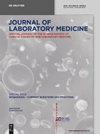Increased hemolysis rate in plasma tubes after implementation of a fully automated sample delivery and acceptance system
IF 1.1
4区 医学
Q4 MEDICAL LABORATORY TECHNOLOGY
引用次数: 0
Abstract
Abstract Objectives Automated sample delivery and laboratory acceptance systems (PTAS) may influence the hemolysis rate of blood samples due to g-forces, abrupt acceleration, and rapid deceleration. However, quantitative data regarding the rate of hemolysis in PTAS is limited. To fill this void, the effect of a pneumatic tube in combination with an acceptance system (PTAS) on the hemolysis rate was investigated in this study. Methods Lithium heparin plasma tubes were transported from different clinical departments to the hospital’s laboratory (a) by employees or (b) with an automated PTAS and analyzed for the presence of hemolysis based on a hemolysis index (HI) of >25. Hemolysis indices of 68.513 samples were retrieved from the laboratory information system before and after installation of the PTAS and were subjected to statistical analysis. Results A total of 32.614 samples were transported by employees, of which 3.815 samples (11.70%) were hemolytic, and 9.441 out of 35.899 samples delivered by PTAS (26.30%) were hemolytic. After the implementation of the PTAS, hemolysis rates increased in all departments. Conclusions Automated PTAS are associated with increased hemolysis rates. This has implications for routine patient management and should be considered for the transportation of samples used for the determination of hemolysis-sensitive laboratory parameters.在实施全自动样品输送和验收系统后,血浆管中的溶血率增加
摘要目的自动送样和实验室验收系统(PTAS)可能会由于重力、突然加速和快速减速而影响血液样品的溶血率。然而,关于PTAS溶血率的定量数据有限。为了填补这一空白,本研究调查了气动管与接受系统(PTAS)对溶血率的影响。方法将不同临床科室的肝素锂血浆管(a)由员工或(b)由自动PTAS运送至医院实验室,根据溶血指数(HI) bbb25分析是否存在溶血。从PTAS安装前后的实验室信息系统中检索溶血指标68.513份,并进行统计分析。结果员工共运送标本32.614份,其中溶血标本3.815份(11.70%),PTAS运送标本35.899份中溶血标本9.441份(26.30%)。实施PTAS后,各科室溶血率均有所提高。结论:自动PTAS与溶血率升高相关。这对患者的日常管理有影响,在用于测定溶血敏感实验室参数的样品运输时应考虑到这一点。
本文章由计算机程序翻译,如有差异,请以英文原文为准。
求助全文
约1分钟内获得全文
求助全文
来源期刊

Journal of Laboratory Medicine
Mathematics-Discrete Mathematics and Combinatorics
CiteScore
2.50
自引率
0.00%
发文量
39
审稿时长
10 weeks
期刊介绍:
The Journal of Laboratory Medicine (JLM) is a bi-monthly published journal that reports on the latest developments in laboratory medicine. Particular focus is placed on the diagnostic aspects of the clinical laboratory, although technical, regulatory, and educational topics are equally covered. The Journal specializes in the publication of high-standard, competent and timely review articles on clinical, methodological and pathogenic aspects of modern laboratory diagnostics. These reviews are critically reviewed by expert reviewers and JLM’s Associate Editors who are specialists in the various subdisciplines of laboratory medicine. In addition, JLM publishes original research articles, case reports, point/counterpoint articles and letters to the editor, all of which are peer reviewed by at least two experts in the field.
 求助内容:
求助内容: 应助结果提醒方式:
应助结果提醒方式:


